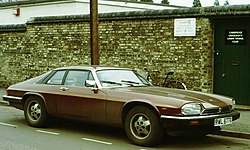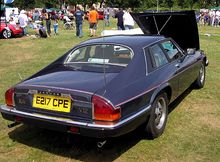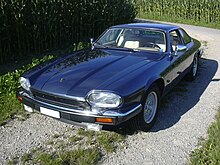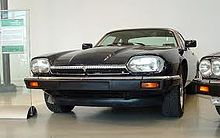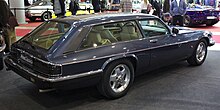Jaguar XJS
| jaguar | |
|---|---|
|
Jaguar XJ-S HE 1982
|
|
| XJ-S and XJS | |
| Production period: | 6 / 1975-4 / 1996 |
| Class : | Upper class |
| Body versions : | Coupé , convertible |
| Engines: |
Petrol engines : 3.6–6.0 liters (147–243 kW) |
| Length: | 4770 mm |
| Width: | 1793 mm |
| Height: | 1254 mm |
| Wheelbase : | 2591 mm |
| Empty weight : | 1800 kg |
| Previous model | Jaguar E-Type |
| successor | Jaguar X100 |
The Jaguar XJ-S or XJS is a Gran Turismo from the traditional British car manufacturer Jaguar . Approx. 115,413 copies were produced from June 1975 to April 4, 1996, making it the most successful Jaguar sports model to date. There are a total of about 21 model variants in 3 consecutive series.
With the last Jaguar E-Type , which was produced in September 1974, Jaguar gave up the market for roadster sports cars, for which the English auto industry was known with brands such as Jaguar, Triumph and MG . New legal framework conditions, particularly in the USA , caused Jaguar to favor the development of a fast, comfortable coupe (GT) over a roadster. The lines of the XJ-S 5.3 GT Coupe (Series 1), which was developed on the basis of the XJ sedan and equipped with the V12 engine from the E-Type Series III, was initially controversial.
Models
XJ-S 5.3 GT Coupe "Pre-HE" (Series 1: 1975–1981)
On September 10, 1975, the XJ-S 5.3 GT Coupe (Series 1) was presented at the IAA in Frankfurt am Main , which was based on the XJ Series II (the wheelbase was around 25 cm shorter at 2.59 m than with the sedan XJ 12), with a closed 2 + 2 seater body and the V12 engine in the injection version that was just ready for series production at the time. With a Cd value of 0.39, its shape was demonstrably more streamlined than that of the E-Type, which has since gone out of fashion, but also more massive and heavier than the E-Type V12 2 + 2. The XJ-S 5.3 GT Coupe "Pre-HE" (Series 1) was the fastest and most expensive Jaguar in the model range at the time, and Jaguar hoped to attract buyers from other luxury brands such as Maserati and Ferrari with this model . Compared to models like the Porsche 911 and the Mercedes-Benz SL , the Jaguar XJ-S 5.3 GT Coupe is faster, but the fuel consumption is also slightly higher. The top speed is 241 km / h and the Coupe accelerates in 6.8 s (manual transmission ) and 7.9 s (automatic) from 0-100 km / h. In addition, it was characterized by excellent road holding and demonstrated a very independent character in this model segment. The XJ-S 5.3 GT Coupe (series 1) was available initially only with the 5.3-liter V12 with 211 kW (287 hp). When it was introduced, there was initially a three-speed automatic transmission (Borg Warner Type 12) and later a four-speed manual transmission (the latter was only available in a piece number of 352 copies produced). When it was launched, the XJ-S 5.3 GT Coupe (Pre-HE) was the fastest and most expensive vehicle from Jaguar's range.
This model also gained fame through the successful British television series Simon Templar - A Gentleman with a Halo (1978–1979), in which Ian Ogilvy drove a white XJ-S 5.3 GT Coupe (Pre-HE) with the registration number ST-1 as Simon Templar . A black XJ-S 5.3 GT Coupe (Pre-HE) with additional tank from 1978 won the 1979 Cannonball race from New York to Los Angeles (4628 km) in 32 hours and 51 minutes (average speed: over 140 km / h) . The record lasted until 1983.
XJ-S 5.3 HE Coupe (Series 2: 1981–1991)
After the production of just over 1,000 cars had reached a low in 1980, there were brief considerations about discontinuing production. Under the new Jaguar boss John Egan , however, it was decided to revise the XJ-S 5.3 GT Coupe (Pre-HE) and offer additional versions, including a convertible that has long been desired by customers.
The new XJ-S 5.3 HE Coupe (Series 2) was therefore presented as early as the summer of 1981 and equipped with a more modern injection system that now brought the engine to 220 kW (295 hp). In addition, the new HE ( High Efficiency ) cylinder head was used, which contributed to a reduction in fuel consumption of more than 20%. Jaguar also improved the quality considerably and changed many details (wooden inlays on the dashboard, less bulky bumpers with a chrome strip on the upper edge, new rims, new seats, etc.), which immediately increased sales figures significantly. The highest production rates in the entire XJ-S / XJS model history were reached in 1988 and 1989, with over 10,000 vehicles built annually. The fully convertible version XJ-S 5.3 V12 Convertible (Series 2), which was newly introduced in 1988 and immediately appealed to a completely new group of buyers, played a major role in this success.
XJ-S 3.6 Coupe (Series 2: 1983–1991)
In the spring of 1983, the XJ-S 3.6 Coupe (Series 2) featured the newly developed successor to the almost 40-year-old XK six-cylinder engine for the first time. It was a 3.6-liter in-line six-cylinder (AJ-6) with two overhead camshafts and 4 valves per cylinder, which developed 163 kW (222 hp). With this AJ-6 engine and a five-speed manual transmission from Getrag , the new XJ-S 3.6 Coupe (Series 2) reached a top speed of 225 km / h. Thanks to the new injection system and the newly developed 4-valve technology, consumption was now lower than with the old engine. This 3.6 version with AJ-6 engine and 5-speed manual transmission is also particularly rare. As an alternative to the 5-speed manual transmission, a four-speed automatic transmission from ZF was also available on request from 1987 . From the 1989 model year, the XJ-S 3.6 Coupe was only available with a new regulated three-way catalytic converter, which reduced the output to 147 kW (199 PS).
XJ-SC 3.6 (Series 2: 1983–1988), XJ-SC 5.3 HE (Series 2: 1985–1988),
XJ-S 5.3 V12 Convertible (Series 2: 1988–1991)
In autumn 1983 the XJ-SC 3.6 was presented, a convertible with Targa roof and foldable rear window - initially only with the new AJ-6 six-cylinder, from 1985 also as the XJ-SC 5.3 HE with the 5.3 HE V12. The conversion of the XJ-SC bodies was initially organized in a rather complex manner and made it necessary to transport them to and from several plants. After a few successful changes in the plant, after about two years everything could finally be manufactured again at one location. Of course, customers continued to long for a "strapless" convertible, which was previously only available as a subsequent conversion at Hess & Eisenhardt in the USA, Lynx in England and Arden in Germany. The XJ-SC was therefore a transitional model, as Jaguar was busy developing a torsion-resistant convertible based on the XJ-S 5.3 HE Coupe (Series 2). In February 1988, the XJ-S 5.3 V12 Convertible (Series 2) was presented to the world for the first time as a fully convertible at the Geneva Motor Show. The prototype was developed on behalf of Jaguar together with the roof specialist Karmann in Osnabrück and is still in the Karmann collection today. The XJ-SC, on the other hand, was not received as well. Neither the press nor the market saw it as a full-fledged convertible at the time. The production figures for the XJ-SC 3.6 came to about 1088 pieces. The XJ-SC 5.3 HE even produced around 3925 vehicles.
XJR-S 5.3 Coupe (Series 2: 1988–1989), XJR-S 6.0 Coupe (Series 2: 1989–1991)
XJR-S 6.0 Coupé and Convertible (Series 3: 1991–1993)
From 1982 the Jaguar XJ-S TWR Racing was successfully used by Team Tom Walkinshaw Racing (TWR for short) in the European Touring Car Championship (ETCC) and won the European Championship for the first time in 1984. Tom Walkinshaw himself was named European Driver Champion - an honor that the predecessors XK and E-Type had always been denied. In this context, TWR has been offering a rather distinctive TWR spoiler set for the XJ-S Coupé (Series 2) and the XJ-SC series since 1984. Using these TWR accessories, the new series model XJR-S-5.3-Coupé was created in England in spring 1988, which was technically similar to the XJ-S-5.3-HE-V12. The launch of this model was celebrated with a special Le Mans edition limited to 50 units (TWR had recently won Le Mans with the Jaguar XJR-9). The TWR aerodynamic kits were then still available for production vehicles and many derivatives were created by third-party companies during this time. In 1991, the external changes to the new XJS facelift were also adopted for the XJR S 6.0 Coupé series models (approx. 124 units produced) and a 6.0 liter V12 engine developed by TWR was introduced at the same time. This engine was not the 6.0 liter V12 with modified cylinder head used by Jaguar from 1993 in the XJS 6.0 Coupé. The German version of the XJR-S 6.0 Coupé developed 243 kW (330 PS) at 5250 rpm, achieved a top speed of 254 km / h and had a three-speed automatic transmission without a torque converter lock-up clutch. Due to the slip over the converter, it reached 6 km / h less top speed than the later XJS-V12 with 222 kW (302 hp) at 5350 rpm. The XJS-V12, available from 1993 onwards, had a 4-speed automatic transmission from GM (model 4L80E) with a torque converter lock-up clutch and the overall ratio was consistently designed for maximum top speed (total ratio 2.65 versus 2.88 (XJR-s), with the converter slip the engine speed can be even higher).
At the end of the XJR-S 6.0 series, there were also 50 XJR-S 6.0 Convertibles for the first time, exclusively for the American market in the colors Jet Black (25 pieces) and Signal Red (25 pieces).
XJS 4.0 Coupe and Convertible (Series 3: 1991–1996), XJS 5.3 Coupe and Convertible (Series 3: 1991–1993),
XJS 6.0 Coupe and Convertible (Series 3: 1993–1996)
The entire XJ-S series was completely revised again in May 1991 (now under Ford management) and offered under the name "XJS" (Series 3). A thoroughly revised version of the entire XJ-S series was completed internally at Jaguar as early as 1988, but for financial reasons (sale of existing stocks) it was only gradually transferred to series production from 1991 to 1993. The total conversion cost Jaguar over £ 50 million. The most noticeable changes from 1991 to the exterior of the new XJS Coupe were new split taillights in black tinted rectangular shape, a new radiator grille and the front, now frameless and rear glued side windows. The position of the rear window moved further back in the lower area to make room for more modern seat belts and was now inclined more clearly forwards.
Much under the sheet metal was redesigned to simplify production with larger sheets and to reduce costs. The dashboard has been redesigned with additional round instruments. To distinguish them from older XJ-S versions, these younger XJS models from 1991 are usually referred to as XJS "Facelift" (or Series 3).
The new Jaguar XJS (Series 3) was first launched in 1991 as the XJS 4.0 Coupe with the 4.0 liter six-cylinder (AJ-6) either with a five-speed manual gearbox or a ZF four-speed automatic and as the XJS 5.3 Coupe or XJS 5.3 Convertible with the 5.3 liter V12 offered with GM400 three-speed automatic. In 1992 the new, very successful XJS 4.0 Convertible followed with the AJ-6 engine and 163 kW (222 PS).
In the spring of 1993 Jaguar increased the displacement of the V12 from 5.3 to 6.0 liters. It now developed 222 kW (302 hp). The XJS 6.0 V12 was equipped with a more modern four-speed automatic from General Motors. With the new 6.0 engine developed by Jaguar itself, the XJR-S 6.0 with its differently constructed 6.0 liter V12 became superfluous. The top speed for the redesigned XJS 6.0 Coupe was now 260 km / h, for the XJS 6.0 Convertible 257 km / h. Both vehicles were not limited to 250 km / h.
For the 1993 model year, the chrome-plated bumpers were replaced by aerodynamically improved plastic bumpers painted in the vehicle color with attached chrome strips, and modified door locks and latches were used. The new components were not installed on a certain date, but gradually as soon as the remaining stocks in stock were used up, so that many transition models can be found. The new rear axle from the sedan was also installed at this time, so that from 1993 the XJS (Series 3) also had maintenance-friendly external disc brakes. A driver airbag was introduced, and from model year 1994 also a front passenger airbag. In the convertible, the lockable storage space behind the seats was omitted in favor of a second bench seat (2 + 2), which was previously only available as a special conversion from Arden , and the dashboard was again slightly redesigned from the center console. The cars of this year can be recognized by their five-spoke wheels or the BBS cross-spoke wheels (special equipment) and the flat, side (previously square, attached) indicators on the front fender. For the first time, the 6.0 models were each given a V12 emblem on the front fenders.
The “Insignia” special equipment, which was also available for the sedan, also fell into this production period. For a five-digit surcharge, the interior has been upgraded with a particularly elaborate leather interior (available in 10 colors), fine wood veneers and Wilton carpets. Vehicles with this equipment (number of XJS - INSIGNIA approx. 64) are extremely rare. These vehicles had INSIGNIA emblems on the front fenders.
In July 1994 the leather interior was modified again for the 1995 model year. The XJS 6.0 V12 was the first to use particularly high-quality shirred leather, the backs of the seats were covered with leather for the first time, and the chrome trim strip and carpet application on the doors were omitted in favor of additional leather. Although the Insignia equipment was no longer available, the interior of the 6.0 V12 models largely corresponded to that of this equipment line with the exception of the missing leather applications on the A-pillar, the dashboard and the parcel shelf.
The black AJ-6 engine with 163 kW (222 hp) was replaced from July 1994 by a new silver AJ-16 engine, which was also available in the newly introduced sedan. This was the further development of the AJ-6 and now had an output of 171 kW (233 PS) on the XJS 4.0 AJ-16. The top speed was now 237 km / h for the XJS 4.0 Coupé and 234 km / h for the XJS 4.0 Convertible. Externally, the vehicles from this construction period can be recognized by the missing stuck-on side stripes as well as the exterior mirrors and headlight borders painted in the vehicle color. Furthermore, all six-cylinder (AJ-16) of this construction period were only equipped with the well-known five-spoke wheels.
From July 1995 the XJS 4.0 (AJ-16) was offered exclusively in the "Celebration" version, in memory of the first use of the Jaguar name 60 years ago. Now there were chrome-plated mirrors and headlight surrounds again, for the first time hand-painted decorative stripes (coach lines) on the sides and new, almost full-surface wheels with 11 spokes. All previous extras, with the exception of the on-board computer and high-pressure headlamp cleaning system, were now installed ex works as standard in this special edition. The interior was further enhanced by a leather steering wheel rim, some of which was made of wood, and an automatic selector lever made of wood. The 6.0 V12 was no longer listed in the price list in 1995 and was only built on request, so that it was not officially available in the “Celebration” version, but was even better equipped with its extensive leather applications.
The very last XJS (Series 3) of both engines (4.0 and 6.0) built from autumn 1995 can be recognized by a handbrake lever with a round black handle. It was no longer chrome-plated, but covered with leather and was also used in this form in the successor model XK8 and in the Aston Martin DB7.
Even in the last year of production 1996, after the successor XK8 had already been announced, more than 3000 XJS 4.0 Celebration Convertibles were delivered. The XJS 4.0 Celebration Coupé was now rather rare in comparison with a total of around 120 units. The last 6.0 V12 left the Jaguar factory in Coventry (as the last XJS ever) on April 4, 1996 as the XJS 6.0 Coupe in the color Ice Blue-Micatallic, the last with a 4.0-liter engine (as the penultimate XJS) on April 4. April 1996 as XJS 4.0 Celebration Convertible in Signal Red. Both vehicles went straight to the Jaguar Museum Collection and are still presented in almost new condition at trade fairs around the world.
Special bodies
- At the beginning of the 1980s, Jaguar designed a Daimler version of the XJ-S. The main difference between the Daimler XJ-S and the basic model, apart from the radiator grille typical of the brand, was a tight notchback with a steep rear window. The rear roofline was similar to that of the later XJ-SC. Series production of the Daimler XJ-S did not materialize. Only a single vehicle was created that is now in the Coventry Automobile Museum.
- Lynx in East Surrey manufactured the Lynx Eventer from 1983 to 1996, a conversion of the XJ-S / XJS Coupés into a three-door sports suit that was generally regarded as high quality. 67 vehicles were built in 14 years. Almost all vehicles have been preserved to this day and are in collectors' hands.
- Apart from drive technology modified models, Arden Automobilbau manufactured a number of vehicles with their own roof structures. These included the Arden AJ 2B (a full convertible), the AJ 3 (a sports suit in the style of the Lynx Eventer) and the AJ 6 (a coupé with a fixed notchback that was similar to the Daimler XJ-S).
The XJ-S / XJS today
The XJ-S (Series 1 and 2) or XJS (Series 3) is rarely seen on today's streets for more than 22 years after its end of production. This is due, on the one hand, to the fact that the number of units built is comparatively low, and on the other hand, because XJ-S / XJS owners rarely use it as an everyday car. The market for used XJ-S / XJS is still relatively large and the spare parts supply can be described as good. While almost all spare parts for the younger XJS model years (series 3: 1991–1996) can be obtained directly from Jaguar dealers, the older XJ-S models (series 1: 1975–1981 and series 2: 1981–1991) In some cases, private sellers or specialized dealers, most of them in the USA or Great Britain, are used. Today, almost exclusively XJ-S HE models (series 2) from model year 1981 and XJS facelift models (series 3) from model year 1991 are offered on the European used market. An XJ-S HE Coupe (Series 2) is comparatively cheap to buy, which does not necessarily apply to maintenance. The open versions of the XJ-S V 12 Convertible (Series 2) are usually more expensive than the corresponding coupé versions. With the coupés, the various special editions (Insignia, Collection-Rouge, Collection-Classic and Celebration) are in great demand because of the low number of units. The current market prices start at around € 6,000 for early XJ-S HE Coupe (Series 2) in moderate condition from the 1980s and reach over € 40,000 for the very well-preserved XJS Convertible (Series 3) of the years of construction 1994-1996. The vehicles of the last years of construction (series 3) were of high quality and had partially galvanized bodies. Today they are particularly popular as the XJS Convertible (Series 3) in the 2 + 2 version as 4.0 and 6.0 and are considered to be of stable value. The XJ-S Lynx Eventer (Shooting-Break) and the R-Sport models XJR-S 6.0 Coupe and XJR-S 6.0 Convertible now occupy a special position.
In recent years, the demand for younger XJS facelift models in Europe has also been satisfied by US imports whose technology does not exactly correspond to the versions sold in Europe (exhaust aftertreatment and engine control) and whose engines provide a slightly lower performance. Externally, the US models can be recognized by the third brake light, the missing turn signal in the fender (here Jaguar emblem), the license plate frame on the rear, the rear spoiler on the XJS 6.0 V12 Convertible and the other speedometer. They can also be clearly identified by their chassis number - the sixth letter is an "X". Vehicles delivered to Europe have the letter "A" at this point.
literature
- Andrew Whyte: Jaguar, The History of a Great British Car. Patrick Stephens Ltd, 1980.
- Lord Montagu of Beaulieu: Jaguar. 4th Edition, The Anchor Press Ltd, 1982.
- Heiner Stertkamp: Jaguar - The complete chronicle from 1922 to today. 2nd edition, Heel-Verlag (2006), ISBN 3-89880-337-6 .
- Nigel Thorley: You & your Jaguar XJS. 2nd Edition, Haynes Publishing, ISBN 1-84425-234-5 .
- Graham Robson: Jaguar XJ-S, The Complete Story. Crowood Press, ISBN 978-1-86126-933-1 .
- Brian Long: Jaguar XJ-S homage to the Super GT. Heel-Verlag (2016), ISBN 978-3-95843-170-6 .
- Klaus Westrup: My special angel. Out of line: cars you will never forget. Memories of the Jaguar XJ-SC 3,6 In: Motor Klassik. Issue 12/2010, p. 34.
Web links
Individual evidence
- ↑ Motor Klassik, issue 12/2010, p. 34 f.
- ↑ Jaguar XJ-S - the successor to the most beautiful sports car of its time Many historical pictures on zwischengas.com (last accessed September 12, 2016)
- ↑ Short model description and pictures at www.austin-rover.co.uk in the section "AR Cars / Jaguar XJ-S" ( Memento of the original from October 4, 2003 in the Internet Archive ) Info: The archive link has been inserted automatically and has not yet been checked . Please check the original and archive link according to the instructions and then remove this notice.
| Jaguar models timeline from 1945 to 1970 | ||||||||||||||||||||||||||
|---|---|---|---|---|---|---|---|---|---|---|---|---|---|---|---|---|---|---|---|---|---|---|---|---|---|---|
| Type \ vintage | Independently | BMH | British Leyland | |||||||||||||||||||||||
| 1940s | 1950s | 1960s | ||||||||||||||||||||||||
| 5 | 6th | 7th | 8th | 9 | 0 | 1 | 2 | 3 | 4th | 5 | 6th | 7th | 8th | 9 | 0 | 1 | 2 | 3 | 4th | 5 | 6th | 7th | 8th | 9 | 0 | |
| upper middle class | 2.4 Liter / 3.4 Liter (Mark I) | Mark 2 2.4 / 3.4 / 3.8 | 240/340 | |||||||||||||||||||||||
| 1 ½ liter | S-Type (3.4 S & 3.8 S) | |||||||||||||||||||||||||
| Upper class | 2 ½ liters | Mark V 2½ | 420 | XJ 6 (Series 1) ... | ||||||||||||||||||||||
| 3 ½ liter | Mark V 3½ | Mark VII | Mark VIII | Mark IX | Mark X | 420 G | ||||||||||||||||||||
| Sports car | XK 120 | XK 140 | XK 150 | E-Type 3.8 | E-Type 4.2 (Series 1) | E-Type 4.2 (Series 2) | ||||||||||||||||||||
| High-performance sports car | XK-SS | |||||||||||||||||||||||||
| race car | C-type | D-type | E-type | XJ 13 | ||||||||||||||||||||||
